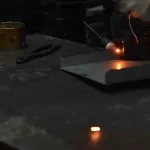Welding finds applications in a wide range of industries, including construction, transportation, agriculture, and professional services. It is an invaluable skill that offers versatility, allowing welders to work in almost any industry.
In this beginner’s guide to welding, we’ll look at:
Welding Town
What welding is
How to get started
The different types of welding
The welding process
Careers in welding
What is welding?
Welding is a highly versatile process that involves the use of intense heat to melt and fuse materials, typically metals, together. Unlike other metal-joining methods like soldering and brazing, welding involves melting the base metals, resulting in a stronger and more robust structure.
To generate the high temperatures required for welding, various heat sources can be employed. These sources include electricity (as in arc welding processes like MIG, TIG, and stick welding), gas flames (as in oxy-fuel welding), lasers, electron beams, friction, and even ultrasound.
The wide range of heat sources enables welding to be performed in diverse environments and under various conditions. Welding can be carried out in almost any location, including underwater, in outer space, and in challenging industrial settings.
The ability to join metals using welding techniques plays a critical role in numerous industries, including construction, manufacturing, automotive, aerospace, shipbuilding, and more. It provides the means to create durable and structurally sound connections, allowing for the fabrication of complex structures and components.
With its versatility and broad application, welding has become an indispensable process in modern industry and continues to advance with new technologies and techniques.
How to get started with welding
Welding can initially appear daunting due to the high temperatures involved and the use of electricity and gas. However, with some patience and dedication, certain types of welding can be relatively easy to learn. There are numerous introductory opportunities available for individuals interested in exploring welding, including:
- College courses or degrees: Many schools, colleges, and even welding stores offer welding courses that provide structured education and training. These courses can range from basic introductory classes to more advanced programs that lead to certifications or degrees.
- Scholarships: Scholarships are available for those pursuing bachelor’s or associate degrees in welding. These scholarships can provide financial support and help individuals further their education in welding.
- On-the-job training: Securing a job that involves welding can be an excellent way to develop practical skills and gain real-world experience. Many employers offer on-the-job training programs where individuals can learn and refine their welding techniques under the guidance of experienced professionals.
- Metal art classes: Local metal art classes can provide exposure to welding while exploring the artistic side of the craft. These classes offer an opportunity to work with metals and learn basic welding techniques in a creative and engaging environment.
- Self-teaching: For those with the time, resources, and budget, investing in a personal welding kit and teaching oneself can be a viable option. Online tutorials, instructional books, and videos can provide guidance and instruction for self-learning.
By taking advantage of these introductory opportunities, individuals can begin their journey into welding and gradually build their skills and knowledge. Whether through formal education, on-the-job training, or self-guided learning, there are numerous paths to explore and develop welding expertise.












